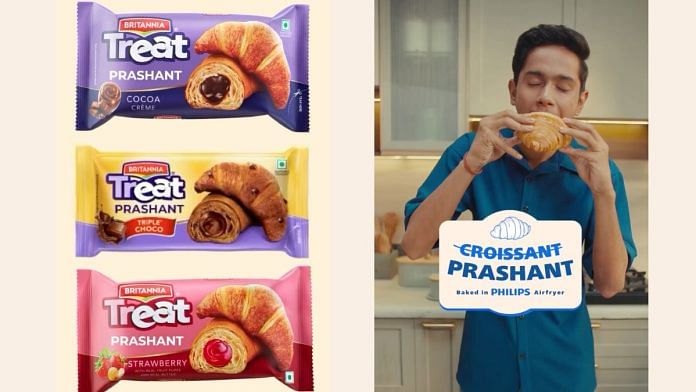One mispronunciation—croissant becoming “Prashant”—has become the internet’s new viral moment. And now, no viral moment is complete without a brand tie-in.
Fast-moving social media trends—those viral moments, audio snippets, memes, and challenges—are completely reshaping the advertising game.
Brands that once thrived on pre-planned campaigns and polished storytelling are now forced to adapt to a chaotic, fast-paced environment where relevance lasts 24 hours—if you’re lucky.
The Prashant moment began with content creator Ayush, @ishowayuu. In the viral video, he is seen guessing the names of bakery items, during which he mispronounces croissant as ‘prashant’.
The video exploded, racking up over 21 million views. Meme pages and celebrities played along but what really made it interesting was how brands jumped on the bandwagon.
Swiggy Instamart, Britannia, Phillips and a few others turned the joke into quick, clever content. While Britania rolled out the exclusive ‘Britannia Prashant pack’, Phillips roped in Ayush to make a croissant with their air fryer.
Also read: Uber hits a six with new IPL campaign—creates buzz, builds connection
Real-time branding
The “Prashant” wave wasn’t just a funny blip—it was a masterclass in real-time branding.
This trend-chasing has birthed a new breed of advertising: agile, informal, meme-literate, and deeply plugged into internet culture.
And, this isn’t the first instance.
Not long ago, former Indian captain Mahendra Singh Dhoni casually revealed the secret to his youthful look during an interview.
“I colour my hair and beard,” he said with his trademark charm, responding to an audience question.
Garnier Hair Naturals, wasted no time turning this moment into a full-fledged campaign, cleverly building on Dhoni’s effortless charisma.
Weeks later, the brand dropped an ad featuring Dhoni and his wife, Sakshi Dhoni.
In the ad, Sakshi teases him about his growing list of candid interviews—specifically referencing the one where he confessed to colouring his hair.
With a knowing smile, she asked, “So, which colour do you use?” Dhoni replies in classic Dhoni style: “I can’t reveal all my secrets just yet.”
As of today, the ad has 314 million views on Instagram, making it the most-watched post among the brand’s 1,600 uploads.
The takeaway is that brands no longer have the luxury of spending months perfecting a campaign.
Ideas are brewing in real-time on social media—brands need to stay agile and ready to act.
Also read: New Cadbury ad has fresh take on the language debate. Both north and south are impressed
Tearing down the wall
This shift also redefines who advertises.
Micro-influencers, content creators, and even anonymous meme pages now hold more sway over purchasing decisions than traditional celebrities.
Brands are tapping into these digital personalities for native promotions that blend into the trend ecosystem seamlessly. Think a viral GRWM (get ready with me) reel that casually slips in a makeup product, rather than a polished TV ad.
Ganji Chudail, the animated character from the Majedar Kahani YouTube channel, transitioned into a brand ambassador with Netflix, Swiggy Instamart, and Nykaa using the character in their campaigns.
Similarly, the viral “Rasode mein kaun tha?” (who was in the kitchen?) meme, was used to create advertising campaigns by brands like Netflix, Zomato, and even Paytm.
The pace is relentless.
Small businesses can go viral overnight with the right reel or caption. Meanwhile, big brands must remain humble and nimble or risk becoming digital dinosaurs.
Ultimately, fast-moving social media trends are tearing down the wall between content and commerce.
Advertising isn’t something you scroll past anymore—it’s something you engage with, laugh at, share, or even turn into a trend yourself. The future of advertising doesn’t just sell a product. It becomes part of culture.
Adapt fast, speak meme, or vanish into irrelevance. That’s the new advertising reality.
(Edited by Theres Sudeep)






